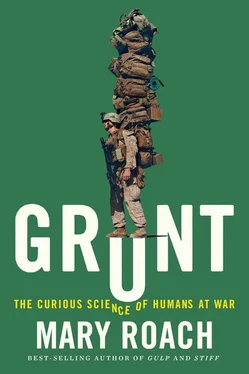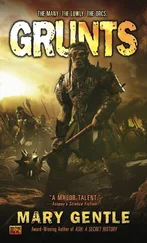That hasn’t stopped military organizations from fantasizing about it. I came across a NATO symposium on Human Performance Optimization that included a roundup of medical technologies that might be repurposed to optimize warfighters. In among the prosthetic limbs “to provide superhuman strength” and the infrared and ultraviolet vision–bestowing eye implants was this: corpus callosotomy to “allow unihemispheric sleep and continuous alertness.” Surgeons have on occasion severed this connector between the brain’s halves as a way of reducing the number of seizures in patients with severe epilepsy. Does this in fact change how these patients sleep? No, says Selim Benbadis, director of the University of South Florida Comprehensive Epilepsy Program and the author of a paper on the procedure. He added that there are infants with incompletely developed corpora callosa and they sleep normally and with both hemispheres at the same time.
“They think a lot of harebrained things are good ideas,” Belenky said of DARPA. Yes, they do. The wish list also included “surgically provided gills.”
“RELEASE OF nuclear weapons has been authorized.” It’s the intercom man again. Even in a simulation, it’s a sickening thing to hear. I look around at the sailors standing near. One untangles an extension cord. His face betrays nothing. A sailor seated at a control console blows his nose. “Is this what it would be like?” I ask Murray. “If it were the real deal? Would people just be calmly carrying out their tasks, blowing their nose…” The whole business is straight off my fathometer.
Murray’s not playing this game. “If your nose is running, you blow it.”
Two sailors hustle past, each holding a corner of what looks at a glance like some kind of Lotto ticket. It’s the code for the key box, the box with the keys to launch the missiles. Two people must have a hand on it at all times once it’s out of safekeeping, for the same reason some airlines, in the wake of the 2015 Germanwings suicide flight, require a second person in the cockpit.
Were this an actual missile launch, I’d wager that adrenaline would keep the crew alert regardless of how long they’d been up. But the normal day-to-day routines of a ballistic missile sub are a good deal less invigorating. Most watches are just that: hour upon hour of watching. Watching displays, readouts, dials, sonar feed. It’s a worrisome mix: sleep deprivation, tedium, and large, potentially destructive items. “The Navy doesn’t want us to publish anything saying that these guys monitoring these nuclear reactors are falling asleep on watch,” Dyche told me. “But we know that’s happening.” Even awake, the tired are poorly suited for standing watch. When psychologists give sleep-deprived people a standard battery of cognitive tasks, their score on measures of “psychomotor vigilance”—paying attention and noticing shit—drops dramatically.
I never visited the Tennessee ’s reactor and its tenders, because I didn’t have security clearance for that part of the sub, but I did visit the torpedo room. There are four of them, massive as medieval battering rams. Sweetly (I guess), they are named for the torpedomen’s wives. I asked the torpedoman on watch when last a US submarine had had cause to fire a torpedo at another vessel. He thought for a moment. “World War II.” He’s the Maytag Repairman, ready for action in the extremely unlikely event it’s called for. The torpedoman’s watch is a checklist of inspections, walk-arounds, paperwork. Always with the paperwork. [57] By weight, a submarine carries more paperwork than it does people—despite the best efforts of Vice Admiral Joseph Metcalf III. Metcalf, who led the invasion of Grenada, waged an equally headstrong campaign for shipboard computerization—“a paperless ship by 1990,” he told the New York Times in 1987. He calculated that even a smaller surface warship carries 20 tons of technical manuals, logs, forms, and shelving—tonnage that could be used for fuel or ordnance. Metcalf’s battle cry (“We do not shoot paper at the enemy”) attracted some media attention and probably one or two spitballs, but—if the USS Tennessee is any indication—no serious commitment to change.
Outside of the sonar shack and the Missile Control Center, much of the Tennessee remains charmingly analog. I looked around the missile compartment at one point and thought, tuba parts. The torpedo launch console has big square plastic buttons—Flood Tube, Open Shuttle, Ready to Fire—that flash red or green, like something Q would have built into James Bond’s Aston Martin. The missile compartment has similarly retro-looking panels of buttons. They provided the setup for one of the more quotable things Murray said to me—a line that, were fewer precautions in place, could have joined “Houston, we’ve had a problem” or “Watch this” in the pantheon of understated taglines for calamity: “I wouldn’t lean on that.”
On an intuitive level, the prospect of marginally vigilant humans babysitting reactors, torpedoes, and weapons of mass destruction is unsettling. That the scene takes place in a vessel under hundreds of feet of water, all the more so. Statistically, however, the highest risk doesn’t lie in the nuclear reactor compartment or even, for that matter, in deep water. The biggest risk lies with the seemingly straightforward but in fact reliably harrowing task of surfacing a sub.
ABALLISTIC MISSILE submarine will take you to the remotest places you’ll ever travel and show you none of it. The sub has no windows or headlights, nothing to make it visible in the surrounding black. Below the depth that sunlight penetrates, a periscope is useless. The crew see by sonar, picking up propeller sounds from ships and plotting their distance and course. To remain undetected, ballistic missile subs use passive sonar only: no pinging. Echolocation—sending out sound and timing its bounce-back—would give away the sub’s own location. The Tennessee is blinder than a bat.
At 450 feet down, our current depth, there are no other vessels to smack into. (Each sub has an assigned territory, or “box,” extinguishing the infinitesimal likelihood that two of them might collide.) The biggest danger outside at the moment is shrimp. When galley crew empty the grind bucket, vast schools of snapping shrimp rush the hull to feed. Their collective tumult can mask engine noise from other vessels.
In the sonar shack this morning, four men sit at monitors, watching snowy green crawls of sonar feed and listening through headsets. A sonarman can identify a ship by propeller noise the way a birder might distinguish one woodpecker species from another by the speed or timbre of the hammering. Someone passes me a headset to hear the click-jabber of some porpoises. After a few days in a submarine, any contact with nature can be a bit heady. “Flipper!” I hate to apply the verb squeal to myself, but that’s what it is.
“Uh huh,” says the sonarman. “Flipper all night long .”
Although ballistic missile subs are able to stay deep for months, they typically do not. The Tennessee surfaces regularly, like a whale, to exhale emails. We’re about to come up in a merchant transit lane, which has everyone a little on edge. In the hour-long lead-up to the moment when the sub breaches the water’s surface, someone’s been at the periscope, face pressed to the eyepiece, scanning for anything sonar might have missed. Because the view is less than 360 degrees, he circles slowly, around and again, crossing one leg behind the other, a slow dance with a canister vacuum. You want to be very, very sure there’s nothing up there.
In 2001, the USS Greeneville surfaced directly beneath a 191-foot Japanese fishery training ship. The sub’s rudder sliced the hull, causing the trawler to sink and resulting in the death of nine people aboard. (Sleep deprivation wasn’t cited as a contributing factor. A group of visitors was: fourteen CEOs and, um, a writer. All but one of the group were up in the control room, crowding the periscope platform, blocking access to critical displays, distracting the sonarmen.)
Читать дальше












